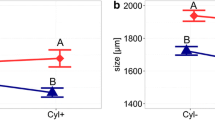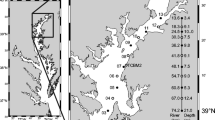Abstract
In this study, we use the model organism Daphnia magna to determine variation in heat tolerance within a natural population and relate this to variation in body fatty acid content and composition. As a proxy for heat tolerance we measured time to immobilization (Timm) for 25 clonal lineages isolated from a single lake. The clonal lineages were grown on Chlamydomonas reinhardii at 15°C. Upon deposition of the first clutch, Timm and body fatty acids were determined. We report significant differences of Timm and of the content of PUFAs and of eicosapentaenoic acid (EPA) among the D. magna clonal lineages. Timm was negatively related to total PUFA-content, indicating that increased body PUFA-content may be detrimental for membrane properties at high temperatures. Juvenile somatic growth varied significantly among clonal lineages, and was not related to total body PUFA-content, hence body PUFA-content was no proxy for PUFA-limitation. No correlative evidence for an impact of body EPA-content on Timm or juvenile growth was obtained. We hypothesize that the observed intra-population variability of body PUFA-content might be related to potentially different amplitudes in diel vertical migration in response to fish. These different amplitudes would mean differences in the extent of diurnal temperature fluctuations among the clonal lineages.




Similar content being viewed by others
Data availability
The datasets generated during and/or analyzed during the current study are available from the corresponding author on reasonable request.
References
Becker, C. & M. Boersma, 2005. Differential effects of phosphorus and fatty acids on Daphnia magna growth and reproduction. Limnology and Oceanography 50: 388–397.
Bradshaw, W. E. & C. M. Holzapfel, 2006. Climate change—Evolutionary response to rapid climate change. Science 312: 1477–1478.
Brzezinski, T. & E. von Elert, 2015. Predator evasion in zooplankton is suppressed by polyunsaturated fatty acid limitation. Oecologia 179: 687–697.
Coggins, B. L., J. W. Collins, K. J. Holbrook & L. Y. Yampolsky, 2017. Antioxidant capacity, lipid peroxidation, and lipid composition changes during long-term and short-term thermal acclimation in Daphnia. Journal of Comparative Physiology B-Biochemical Systemic and Environmental Physiology 187: 1091–1106.
De Meester, L., L. J. Weider & R. Tollrian, 1995. Alternative antipredator defences and genetic polymorphism in a pelagic predator-prey system. Nature 378: 483–485.
Farkas, T., 1979. Adaptation of fatty-acid compositions to temperature—study on planktonic crustaceans. Comparative Biochemistry and Physiology B-Biochemistry & Molecular Biology 64: 71–76.
Geerts, A. N., J. Vanoverbeke, B. Vanschoenwinkel, W. van Doorslaer, H. Feuchtmayr, D. Atkinson, B. Moss, T. A. Davidson, C. D. Sayer & L. de Meester, 2015. Rapid evolution of thermal tolerance in the water flea Daphnia. Nature Climate Change 5: 665.
Guschina, I. A. & J. L. Harwood, 2006. Mechanisms of temperature adaptation in poikilotherms. FEBS Letters 580: 5477–5483.
Harrison, K. E., 1990. The role of nutrition in maturation, reproduction and embryonic development of decapod crustaceans: a review. Journal of Shellfish Research 9: 1–28.
Hazel, J. R., 1995. Thermal adaptation in biological membranes—is homeoviscous adaptation the explanation. Annual Review of Physiology 57: 19–42.
Hazel, J. R. & E. E. Williams, 1990. The role of alterations in membrane lipid composition in enabling physiological adaptation of organisms to their physical environment. Progress in Lipid Research 29: 167–227.
Helmuth, B., J. G. Kingsolver & E. Carrington, 2005. Biophysics, physiologicalecology, and climate change: does mechanism matter? Annual Review of Physiology 67: 177–201.
Huey, R. B., M. R. Kearney, A. Krockenberger, J. A. M. Holtum, M. Jess & S. E. Williams, 2012. Predicting organismal vulnerability to climate warming: roles of behaviour, physiology and adaptation. Philosophical Transactions of the Royal Society B-Biological Sciences 367: 1665–1679.
Jansen, M., A. N. Geerts, A. Rago, K. I. Spanier, C. Denis, L. de Meester & L. Orsini, 2017. Thermal tolerance in the keystone species Daphnia magna-a candidate gene and an outlier analysis approach. Molecular Ecology 26: 2291–2305.
Kristensen, T. N., V. Loeschcke & A. A. Hoffmann, 2007. Can artificially selected phenotypes influence a component of field fitness? Thermal selection and fly performance under thermal extremes. Proceedings of the Royal Society B-Biological Sciences 274: 771–778.
Martin-Creuzburg, D., A. Wacker & T. Basen, 2010. Interactions between limiting nutrients: consequences for somatic and population growth of Daphnia magna. Limnology and Oceanography 55: 2597–2607.
Martin-Creuzburg, D., A. Wacker, C. Ziese & M. J. Kainz, 2012. Dietary lipid quality affects temperature-mediated reaction norms of a freshwater key herbivore. Oecologia 168: 901–912.
Mitchell, S. E. & W. Lampert, 2000. Temperature adaptation in a geographically widespread zooplankter, Daphnia magna. Journal of Evolutionary Biology 13: 371–382.
Müller-Navarra, D. C., 1995. Evidence that a highly unsaturated fatty acid limits Daphnia growth in nature. Archiv für Hydrobiologie 132: 297–307.
Müller-Navarra, D. C., M. T. Brett, A. M. Liston & C. R. Goldman, 2000. A highly unsaturated fatty acid predicts carbon transfer between primary producers and consumers. Nature 403: 74–77.
Müller-Navarra, D. C., M. T. Brett, S. Park, S. Chandra, A. P. Ballantyne, E. Zorita & C. R. Goldman, 2004. Unsaturated fatty acid content in seston and tropho-dynamic coupling in lakes. Nature 427: 69–72.
Parmesan, C. & G. Yohe, 2003. A globally coherent fingerprint of climate change impacts across natural systems. Nature 421: 37–42.
Persson, J., M. T. Brett, T. Vrede & J. L. Ravet, 2007. Food quantity and quality regulation of trophic transfer between primary producers and a keystone grazer (Daphnia) in pelagic freshwater food webs. Oikos 116: 1152–1163.
Schlotz, N., J. G. Sorensen & D. Martin-Creuzburg, 2012. The potential of dietary polyunsaturated fatty acids to modulate eicosanoid synthesis and reproduction in Daphnia magna: a gene expression approach. Comparative Biochemistry and Physiology A-Molecular & Integrative Physiology 162: 449–454.
Schlotz, N., A. Roulin, D. Ebert & D. Martin-Creuzburg, 2016. Combined effects of dietary polyunsaturated fatty acids and parasite exposure on eicosanoid-related gene expression in an invertebrate model. Comparative Biochemistry and Physiology A-Molecular & Integrative Physiology 201: 115–123.
Schluter, L., K. T. Lohbeck, M. A. Gutowska, J. P. Groger, U. Riebesell & T. B. H. Reusch, 2014. Adaptation of a globally important coccolithophore to ocean warming and acidification. Nature Climate Change 4: 1024–1030.
Schwarzenberger, A., S. D‘hondt, W. Vyverman & E. von Elert, 2013. Seasonal succession of cyanobacterial protease inhibitors and Daphnia magna genotypes in a eutrophic Swedish lake. Aquatic Sciences 75: 433–445.
Sinclair, B. J., K. E. Marshall, M. A. Sewell, D. L. Levesque, C. S. Willett, S. Slotsbo, Y. W. Dong, C. D. G. Harley, D. J. Marshall, B. S. Helmuth & R. B. Huey, 2016. Can we predict ectotherm responses to climate change using thermal performance curves and body temperatures? Ecology Letters 19: 1372–1385.
Sommer, U., Z. M. Gliwicz, W. Lampert & A. Duncan, 1986. The PEG-model of seasonal succession of planktonic events in fresh waters 106: 433–471.
Sperfeld, E. & A. Wacker, 2011. Temperature- and cholesterol-induced changes in eicosapentaenoic acid limitation of Daphnia magna determined by a promising method to estimate growth saturation thresholds. Limnology and Oceanography 56: 1273–1284.
Sperfeld, E. & A. Wacker, 2012. Temperature affects the limitation of Daphnia magna by eicosapentaenoic acid, and the fatty acid composition of body tissue and eggs. Freshwater Biology 57: 497–508.
Stich, H. B. & W. Lampert, 1981. Predator evasion as an explanation of diurnal vertical migration by zooplankton. Nature 293: 396–398.
Taipale, S. J., M. J. Kainz & M. T. Brett, 2011. Diet-switching experiments show rapid accumulation and preferential retention of highly unsaturated fatty acids in Daphnia. Oikos 120: 1674–1682.
von Elert, E., 2002. Determination of limiting polyunsaturated fatty acids in Daphnia galeata using a new method to enrich food algae with single fatty acids. Limnology and Oceanography 47: 1764–1773.
von Elert, E. & P. Fink, 2018. Global warming: testing for direct and indirect effects of temperature at the interface of primary producers and herbivores. Frontiers of Ecology and Evolution 6: 87.
von Elert, E. & F. Jüttner, 1997. Phosphorus limitation not light controls the exudation of allelopathic compounds by Trichormus doliolum. Limnology and Oceanography 42: 1796–1802.
von Elert, E. & P. Stampfl, 2000. Food quality for Eudiaptomus gracilis: the importance of particular highly unsaturated fatty acids. Freshwater Biology 45: 189–200.
Wacker, A. & E. von Elert, 2001. Polyunsaturated fatty acids: evidence for non-substitutable biochemical resources in Daphnia galeata. Ecology 82: 2507–2520.
Weers, P. M. M., K. Siewersen & R. D. Gulati, 1997. Is the fatty acid composition of Daphnia galeata determined by the fatty acid composition of the ingested diet? Freshwater Biology 38: 731–738.
Williams, P. J., K. B. Dick & L. Y. Yampolsky, 2012. Heat tolerance, temperature acclimation, acute oxidative damage and canalization of haemoglobin expression in Daphnia. Evolutionary Ecology 26: 591–609.
Windisch, H. S. & P. Fink, 2018. The molecular basis of essential fatty acid limitation in Daphnia magna: a transcriptomic approach. Molecular Ecology 27: 871–885.
Yampolsky, L. Y., T. M. M. Schaer & D. Ebert, 2014. Adaptive phenotypic plasticity and local adaptation for temperature tolerance in freshwater zooplankton. Proceedings of the Royal Society B-Biological Sciences 281: 20132744.
Acknowledgements
This study was supported by the German Science Foundation, DFG, with a Grant to EvE (EL 179/12-1).
Author information
Authors and Affiliations
Corresponding author
Additional information
Guest editors: Linda C. Weiss, Eric von Elert, Christian Laforsch & Max Rabus / Proceedings of the 11th International Symposium on Cladocera
Rights and permissions
About this article
Cite this article
Werner, C., Ilic, M. & von Elert, E. Differences in heat tolerance within a Daphnia magna population: the significance of body PUFA content. Hydrobiologia 846, 17–26 (2019). https://doi.org/10.1007/s10750-018-3769-7
Received:
Revised:
Accepted:
Published:
Issue Date:
DOI: https://doi.org/10.1007/s10750-018-3769-7




